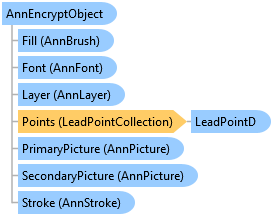| Leadtools.Annotations.Core Namespace : AnnEncryptObject Class |

public class AnnEncryptObject : AnnRectangleObject, IAnnObjectCloneable
Public Class AnnEncryptObject Inherits AnnRectangleObject Implements IAnnObjectCloneable
public sealed class AnnEncryptObject : IAnnObjectCloneable
@interface LTAnnEncryptObject : LTAnnRectangleObject<NSCoding,NSCopying>
public class AnnEncryptObject extends AnnRectangleObject
function Leadtools.Annotations.Core.AnnEncryptObject()
The encrypt annotation object is a rectangular object that is used to encrypt rectangular portions of an image.
It can also be used to encrypt the entire image. In design mode, the encrypt object is visible but partially transparent to show the part of the image that it covers. In run mode, the encrypt object is invisible.
You must call Apply to apply the encrypt object. Once applied, the portion of the image under the encrypt object becomes scrambled, and the encrypt object state changes to decryptor. Using different keys before calling this method gives different scrambling patterns. The decryptor state differs from the encryptor state in that a decryptor cannot be moved, and cannot be changed to an encryptor. The scrambling can be removed by calling Apply on the decrypt object with the appropriate arguments. If successful, the decryptor state changes to encryptor. An encrypt object in the encryptor state can be moved, can have its Key changed, and can be changed to a decrypt object.
The encrypt object is useful for encrypting portions of an image. After encrypting, the scrambled bitmap cannot easily be unscrambled without the associated annotation file. The scrambling can be removed by using the associated annotation file, or by using automation mode to manually change the state from encryptor to a decryptor, position it correctly, and setting the Key appropriately.
Overlapping regions can be encrypted. When encrypting overlapping regions, note the following points:
All annotation objects have an order in which they are drawn (the Z-order)
The encryptors are encrypted from the front of the Z-order to the back
Those that are drawn first are encrypted first. Those that are drawn last ("on top" of other encryptors) are encrypted last
The Z-order can be changed through automation by right-clicking and choosing "Send To Front" or "Send To Back"
The decrypt objects are decrypted in reverse order of the encrypt objects
You cannot rotate an encrypt object, but you can flip or reverse it. If you rotate a container that includes an encrypt object, the encrypt object will move to the new position, but will retain its orientation.
This object includes a PrimaryPicture and SecondaryPicture properties that can be used to customize the picture used when the object is in "encrypt" or "decrypt" mode. Or you can use the DefaultPrimaryPicture and DefaultSecondaryPicture properties to use the default pictures.
Programmatically, the boundaries and location of the encrypt object can be controlled using the following properties:
Each object can be transformed with the following methods:
The AnnEncryptObject class inherits a number of properties from the AnnObject class, providing support for font, stroke and fill characteristics. These properties are listed below:
The name of the ecnrypt object can be controlled using AnnObject.Labels property, inherited from the AnnObject class.
An object can be part of a group annotation object or part of a container object. It cannot be part of both a group and a container at the same time.
The following properties can also be used to programmatically set characteristics of an AnnEncryptObject: